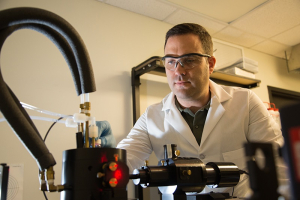A diamond continues to shine in the Cullen College department of chemical and biomolecular engineering. Expert in the world of crystallization, Jeffrey Rimer, Ernest J. and Barbara M. Henley Associate Professor, has scored another award – this time the Joe W. Hightower Award from the American Chemical Society - Greater Houston Section (ACS-GHS). The award is based on “significant contributions in the areas of research, education, and community service,” according to the ACS-GHS.
It’s often hard to highlight milestones in a career that keeps hitting them. Most people know Rimer for his expertise in the processes behind crystal growth and formation, which impacts everything from drug development to the production of chemicals and fuels to pathological diseases such as kidney stones and malaria.
“Jeff’s post-doctoral research and his findings at UH have made critical contributions in the area of drug design for kidney stone disease through the discovery of crystal growth inhibitors, thus marking the first advancement in stone therapy in the past 30 years,” said Michael P. Harold, Chair and M.D. Anderson Professor of chemical and biomolecular engineering at the UH Cullen College of Engineering.
The molecules identified in Rimer’s research are not yet approved as drugs, but that’s the trajectory.
“All of our laboratory results look promising," said Rimer. "The drug that we propose would be used as an agent to slow the rate of crystal growth.” Kidney stones are actually made of crystals that form inside the body.
As you might guess, the research explaining such a leap in the field of the painful kidney stones went viral. Since it appeared in the journal Nature, 77 international news stories appeared along with an entry in Wikipedia.
“I work with several doctors who have told me their patients come in carrying our recent article, asking questions about treatment,” said Rimer. And though Rimer, himself, doesn’t have any kidney stones, he has family members who’ve suffered from them.
“Working on drug development is satisfying in that you feel as though you are doing something that has the potential to improve peoples’ lives,” he said.
Zeolite research
Since arriving at the University of Houston Cullen College in 2009, Rimer has built on elements from both his graduate and postdoctoral studies. His Ph.D research was on zeolites and his postdoctoral work was on kidney stones.
Harold added, “After joining UH, Jeff quickly established a formidable research group in the area of crystal engineering. What has been impressive is Jeff’s ability to make major advances in two different areas of crystallization.”
And the best of all crystals, according to Rimer, are zeolites.
Zeolites have been used for years in the oil and gas industry as catalysts to convert crude oil to gasoline. In fact, their use is credited as one of the most important accomplishments in the last generation to make energy refining efficient. Zeolites take big molecules of crude and crack them into smaller molecules that become gasoline and other byproducts. The process, simply enough, is called hydrocracking.
But as well as these catalysts perform, Rimer thinks they can do better.
“After decades of use in the (petro) chemical industry, there is still substantial opportunities to optimize their performance,” said Rimer. “We’re taking a step back and looking at how these materials crystallize, from which we can learn how to better control their synthesis. In particular, our ability to observe how zeolites grow, in real time, is somewhat of a paradigm shift in the field.”
Malaria therapeutics
Hard to believe, even Rimer admits, but the disease malaria involves crystals, too. To come up with a cure, he’s working with Peter Vekilov, John and Rebecca Moores Professor of chemical and biomolecular engineering at the Cullen College.
Most malaria cases occur in equatorial regions of the world from parasites delivered to humans by a mosquito bite. Parasites infiltrate the bloodstream and attack red blood cells. The parasite catabolizes, or destroys, hemoglobin in the red blood cell, which releases toxins (e.g., heme molecules) that crystallize.
“We are studying the crystallization of heme using a biomimetic protocol developed in our labs. With this platform, we have been able to assess the role of antimalarial drugs as modifiers that slow the rate of crystal growth,” said Rimer. “We feel that the knowledge we’ve gained has established a nice platform to screen crystal modifiers and to identify lead candidates for new drugs.”
New drugs are needed, he said, because parasites develop resistance to current lines of treatment. “We always have to stay ahead of the game,” Rimer said.
In the crystallization world, Rimer is not only ahead of the game – he seems to set the rules.
